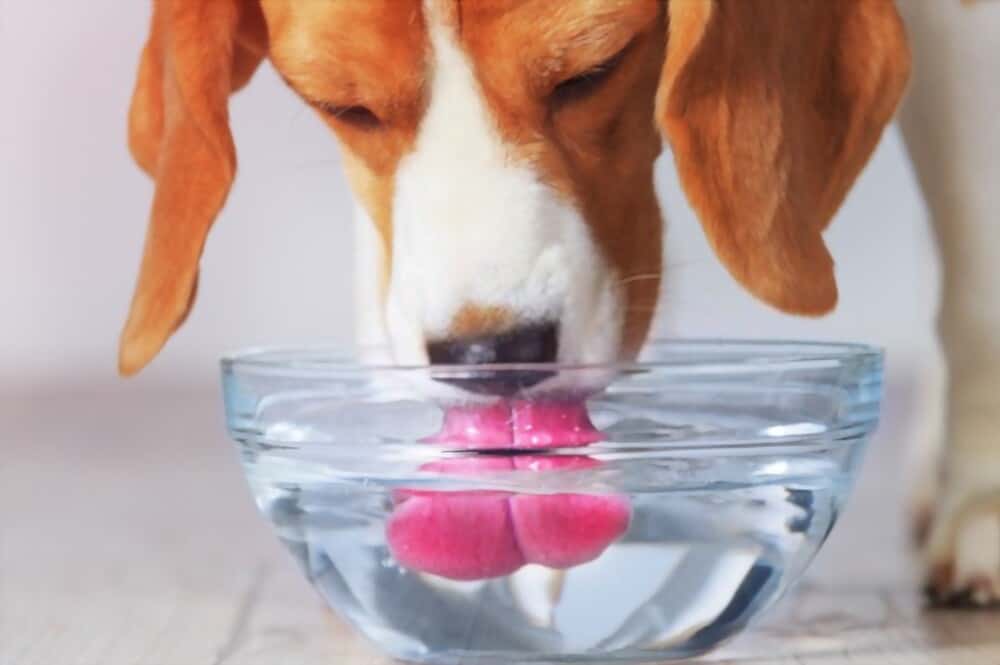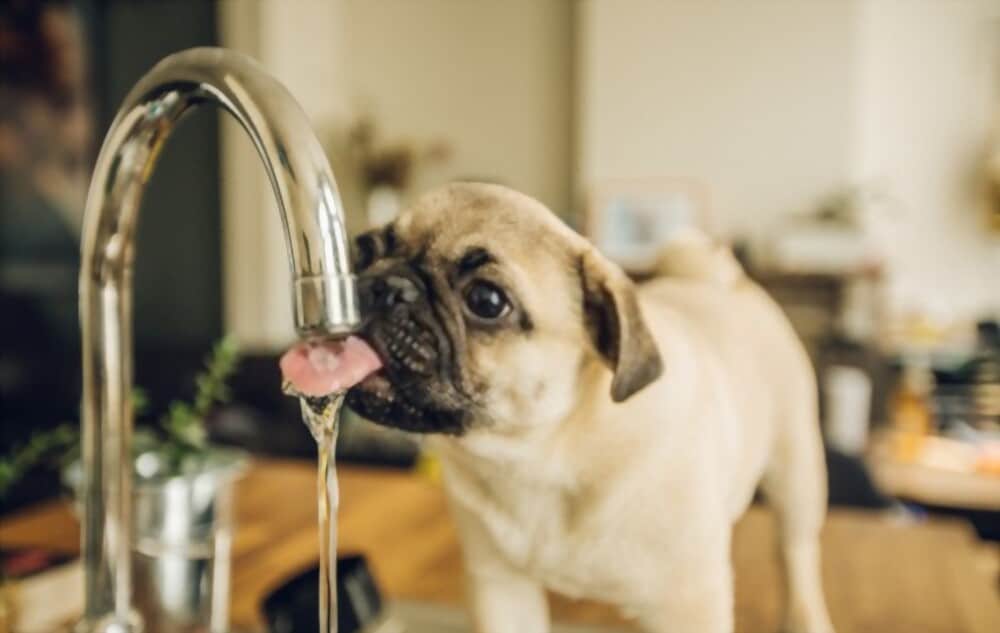
We’re all dog lovers. We also enjoy keeping a few houseplants nearby. Due to the potential dangers, it may be an issue if your dog accidentally drinks water from the saucer of your houseplant.
If they are thirsty, dogs will drink from a plant saucer. The dirt and fertilizers used to grow plants, however, might be harmful to dogs if consumed. Additionally, the soil of the plant may contain parasites and hazardous organic substances that could be harmful to your dog. If you notice anything that worries you, you should take your dog to the vet to be safe.
In this article, I’ll go over what could happen if your dog consumes plant drainage water, how to avoid it, and what symptoms to watch out for if your dog becomes ill after consuming plant drainage.
To better comprehend the situation, I strongly advise you to read this text from beginning to end.
Table of Contents
Will Dogs Get Sick If It Drinks Plant Drainage Water or Stagnant Water?
Dogs may be able to safely drink from still puddles or environments like plant saucers, it seems.
But it’s possible that’s not always the case. For instance, plant saucers may contain pollutants if there are any in the soil. Fertilizers are another component of potting soil that may be hazardous if they seep into the plant’s drainage water.
Any of these elements from a puddle or a plant saucer, including fertilizers, parasites, and bacteria, can make your dog ill. Perhaps this isn’t always the case.
You might be entirely safe using your plant saucer. However, there is still a chance, so you should make an effort to stop your dog from drinking from these locations.
Even if your dog has just had one drink and hasn’t yet become ill, it could become ill. Depending on the toxins in the water, the illness might range from minor to severe. To learn why dogs enjoy plants, read our article.
Because of this, it’s generally a good idea to discourage your dog from consuming any water from a stagnant source.
To quickly and cheaply drain the extra water from my plant saucer, I just used a simple turkey baster. Clicking here will take you there.
What Does the Water in A Plant Saucer Contain?
Fertilizers are present in potting soil. Most likely, the soil in the containers you use for indoor plants also contains fertilizers.
Fertilizer poisoning can result from fertilizer use. To determine whether your dog could become poisoned by fertilizer, you must know what your plant soil contains.
Through the leaching process that occurs every time the plant is watered, fertilizers might easily just wash into the plant’s saucer.
The soil is filled with germs, many of which are invisible to the naked eye. While many of these germs are benign, some of them can be fatal to your dog.
It includes the Leptospirosis-causing germs that can seriously illen dogs.
Everything that is washed away from the soil, including fertilizers, bacteria, algae, fungi, etc., is contained in plant drainage water. Dogs can occasionally become ill from fungus and algae.
It’s possible that your dog won’t get sick at all. However, it is always advisable to keep an eye out for any signs and call the doctor as needed.
How to Prevent Dogs from Drinking Plant Water?
You may stop your pets from drinking from the plant saucer or even eating the plant mud by doing one of three things.
- Adjust position by elevating
- Use barriers by packing the saucer with stones.
- Keep off the water
Placing the plant out of the dog’s reach is the simplest approach to stop them from drinking plant water.
Put it up high, on a shelf, or somewhere else if possible. But it’s probable that’s not always an option.
You might also place a lot of rocks on the plant saucer as an alternative. The purpose of the rocks is to act as a barrier. It might be okay as long as the dog cannot ingest the water directly.
If you think it could help keep your dog away from the plant saucer, you might also create barriers around the plant pot itself.
Not overwatering as much is another excellent idea. To control overwatering, there are plant saucers.
Nine times out of ten, there won’t be any water on the plant saucer if you don’t overwater. Both your dog and your plant will benefit greatly from this exercise.
You might also give the other pet-safe techniques I’ll cover a try.
Use this reasonably priced soil moisture meter from amazon to eliminate guesswork in knowing how much moisture your soil has.
Plant Saucer Alternatives (Pet Safe Plant Drainage Methods)
There are planters that keep pets from accessing the drip tray portion. These might be a great way to stop your dog from consuming plant drainage water.
Some of these even completely conceal the drip tray. Like this Sonder Planter Pot, which conceals the drip saucer and keeps it out of reach of pets.
You should also consider growing plants in hanging pots. Hanging pots are a terrific idea for a pet-safe plant saucer substitute because they don’t have a drip tray and are constantly out of reach of dogs.
A stylish fence around the houseplant is a wonderful technique to deter your pets from drinking from the plant saucer as well.
In addition to keeping the water out of the dogs’ reach, this prevents the need to move or alter the planting pot. If you have huge houseplants, this may come in particularly handy.
Can Plant Drainage Water Contain Insects That Are Harmful to Pets?
In comparison to outdoor soil, indoor plant soil has less insects. But the soil around them is also home to some insects that can be problematic.
Frequently, compost can be used to pot plants. Compost contains microorganisms (microbes) like:
- bacteria
- Fungi
- protozoa
- – Vomiting.Create barriers by packing saucers with stones.
- Stay off the water
Placing the plant in an inaccessible location is the simplest technique to stop dogs from drinking plant water.
Possibilities include placing it high up or atop something, like a shelf. On the other hand, it might not always be possible.
The addition of many rocks to your plant saucer is an additional option. A barrier is made by the placement of the rocks. It may be okay as long as the dog is unable to consume the water directly.
If you think it could help keep your dog away from the plant saucer, you might also place barriers around the entire plant pot itself.
Avoiding excessive overwatering is a good idea as well. In case of overwatering, plant saucers are available to control.

Symptoms to Look for If Your Dog Drinks Plant Water
There won’t be any water on the plant saucer nine times out of ten if you don’t overwater. For both your dog and your plant, this is a very wise approach.
Alternative pet-safe approaches, which I’ll cover next, are another option.
You may use this affordable soil moisture meter from amazon to eliminate uncertainty in measuring how much moisture your soil contains.
Pets can’t access the drip tray portion thanks to planters that block it. If your dog tends to drink plant drainage water, these can be a great remedy.
The drip tray is even completely concealed by some of these. A good example of this is this Sonder Planter Pot, which conceals the drip saucer and keeps pets away from it.
Planting in hanging pots is an additional smart move you might do. For a pet-safe plant saucer substitute, hanging pots are a wonderful option because they lack a drip tray and are inaccessible to dogs.
To further deter your pets from drinking from the plant saucer, you might add a beautiful fence around the houseplant.
Conclusion
By doing this, you may prevent the dogs from accessing the water while avoiding the hassle of moving or altering the planting pot. Having huge houseplants can make this extremely useful.
In comparison to outside soil, dirt for houseplants has less insects. However, they also have a few insects dwelling in the soil, and these insects might be problematic at times.
Compost is frequently used to pot plants and contains microorganisms (microbes) like:
bacteria
FAQ
Can dogs get water borne diseases?
The most prevalent water-borne illnesses that affect dogs are listed below, along with symptoms, cures, and potential side effects from infection. The bacteria that cause leptospirosis, Leptospira spp., are found across the planet and can infect any mammal.
What are the symptoms of Giardia in dogs?
Dogs with giardia infections may experience weight loss, persistent, unpredictable diarrhea, and greasy stools. The stool may be mushy or watery, frequently have a greenish tint, and occasionally have blood in them. Excess mucus is frequently found in the feces of infected dogs. Vomiting could happen occasionally.
What infections can dogs get from water?
Dogs are most frequently exposed to Leptospira bacteria in slow-moving or stagnant water, as well as along the sides of streams and rivers. Dogs are more vulnerable to infection if they have cuts or scratches and are exposed to contaminated water or animal urine.
